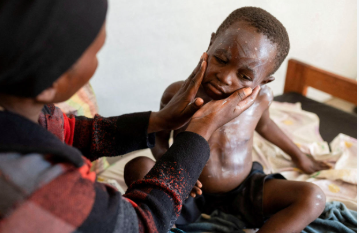A person in California who had just traveled from eastern Africa was the first person in the United States to contract a more aggressive strain of mpox, the country announced on Saturday.
The Centers for Disease Control and Prevention were notified of the case when the California Department of Public Health verified it.
According to a news release from the state’s health agency, the individual is currently recuperating at home after receiving treatment in San Mateo County based on their symptoms and travel history.
According to the statement, “but there is no concern or evidence” that the strain is now spreading in California or the United States, public health officials are reaching out to anyone who had intimate contact with the patient.

According to the CDC, the strain, which can cause more serious sickness than the virus that spread rapidly in 2022, has been found in the U.S., making it the sixth country outside of Africa to do so.
In August, the World Health Organization declared a worldwide public health emergency for the second time in two years due to the spread of this strain in numerous African nations.
Formerly known as monkeypox, mpox is a viral illness that frequently manifests as flu-like symptoms along with painful lesions. Clade I, the more aggressive strain, and Clade II, the relatively gentler strain, are the two separate groups into which it is divided.
The global epidemic in 2022, which caused at least 32,000 illnesses and 58 fatalities in the United States, was caused by Clade II.
Clade I was thought to be endemic in Central Africa and East Africa, and it had not spread outside of these regions until recently. However, eight additional African nations have reported cases this year as a result of an epidemic in the Democratic Republic of the Congo. The first verified case outside of Africa occurred in Sweden in August. Thailand verified a case a few days later. The two patients had been to Africa.
According to the CDC, instances linked to travel have also been found in Germany, India, and the UK.
Direct contact with an infected person, animal, or contaminated objects, including as bedding or clothing, can transmit mpox. Sexual contact, especially between males who had sex with other men, was the main way that the 2022 outbreak of Clade II was propagated.
According to disease specialists, contact with infected animals and transmission inside families have been the main ways that clade I has been spreading during the current outbreak.

According to the Centers for Disease Control and Prevention, children aged 15 and younger accounted for two-thirds of the suspected cases between January 2023 and April 2024. However, sexual interaction between males who have sex with men in Congo and female sex workers has also led to the emergence of a strain known as clade Ib.
Some researchers predict that clade I may spread within the same sexual networks as in 2022, while it’s unknown what the transmission mechanisms may be in the US.
Dr. Marc Siegel, an associate professor of medicine at the George Washington School of Medicine and Health Sciences, stated, “I do anticipate that we will see cases.” “I believe it will most likely occur in the same demographic that was more vulnerable to the epidemic in 2022–2023. I believe there is very minimal risk to the general public.
The present epidemic in the Democratic Republic of the Congo has a mortality rate of about 5%, but previous mpox outbreaks of clade I in Africa have killed up to 10% of those who were ill. This is in contrast to the 2022 outbreak’s 0.2% worldwide death rate.
However, because of lower rates of malnutrition and a stronger health care system, health authorities say there is reason to think that clade I may not be as dangerous in the United States as it has been in African nations this year.
Additionally, compared to 2022, the United States is better equipped to handle an outbreak. The CDC is screening for both clades at wastewater locations nationwide, including several airports, and has directed physicians to test for mpox.
The two-dose Jynneos vaccine, which is offered to men who have sex with males and other high-risk populations, is also widely available throughout the nation. According to the Department of Health and Human Services, a prior infection or two doses of the vaccination should guard against serious clade I sickness.
Between May 2022 and January 2023, the United States delivered approximately 1.2 million doses of the vaccine. Since only 23% of the population at high risk has received all recommended vaccinations, health officials are hoping to increase that coverage.
Usually, mpox begins as a rash that develops into tiny skin bumps, blisters filled with fluid, and then scabs over. In addition, people may have a fever, headache, back pain, muscular pains, low energy, or enlarged lymph nodes.
In the United States, some clade II infected individuals have reported that the sores are quite painful. Historically, they have been seen on the face, chest, palms of the hands, and soles of the feet. However, during the 2022 outbreak, lesions were found within the mouth and throat or around the genital and anal area.





